

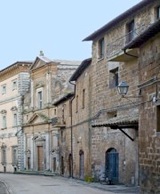
San Bernardino, with Palazzo Crispo Marsciano to the left
and the entrance to the nunnery to the right
In 1451, the Commune gave permission for a community of female Franciscan tertiaries to build a nunnery here, which they dedicated to the recently canonised St Bernardino of Siena. Two years later, the Commune voted to provide a subsidy for the construction of the complex.
The lady who founded the community had apparently been married to one of the Conti di Marsciano. The sisters of her new community were introduced to the appropriate form of life by nuns from the Monastero delle Lucrezie, Todi. This community was affiliated to Sant’ Anna, Foligno and formed part of the congregation formed by Blessed Angelina of Montegiove, who was also related to the Conti di Marsciano.
This community was suppressed in 1544 and the complex passed to a community Poor Clares. They incorporated the palaces to either side into their convent at various times:
-
✴They acquired the property to the right from the bishop at some point, but sold it in 1581 to Vicenzo Buzi. He demolished it to make way for Palazzo Buzi.
-
✴They bought Palazzo Crispo Marsciano to the left from the the Conti di di Marsciano in 1618. This palace subsequently passed to the Commune.
The nuns built a new church here in 1657-66 to a design by Cosimo Poli, the nephew of Bishop Cardinal Fausto Poli.
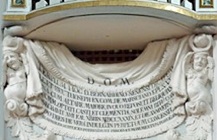
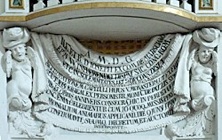
Bishop Giuseppe dei Conti di Marsciano, who consecrated the church in 1739, is commemorated in two inscriptions [on the counter-facade].
Interior
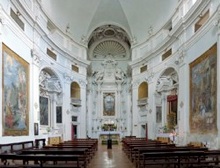
The church, which is one of the few Baroque buildings in Orvieto, has a distinctive elliptical plan. The nuns’ choir is at the rear, above the organ. An inscription records that Sisters Francesca Camilla and Anna Ippolita di Montemarte (who were related to the Conti di Marsciano) donated this organ in 1709.
Madonna and Child with saints (mid 16th century)
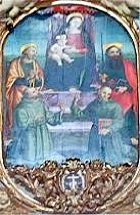
The altarpiece must already have been about 100 years old when it was placed on the high altar of the nuns’ new church. If they had originally commissioned it, this would have occurred soon after they acquired the complex. However, the figures of SS Francis and Bernardino seem to have been painted after the completion of the original altarpiece, and it may be that they acquired it from a non-Franciscan location and adapted it to their purposes.
Water stoup (1588)
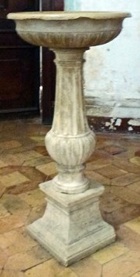
Education of the Virgin (ca. 1650)
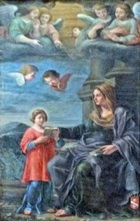
Blessed Angelina of Montegiove (18th century ?)
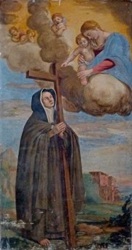
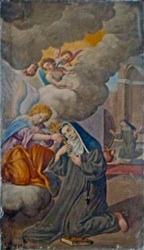
These two panels in the presbytery were possibly commissioned by Bishop Giuseppe dei Conti di Marsciano, who consecrated the church in 1739 and who could claim the Blessed Angelina as an ancestor.

